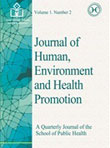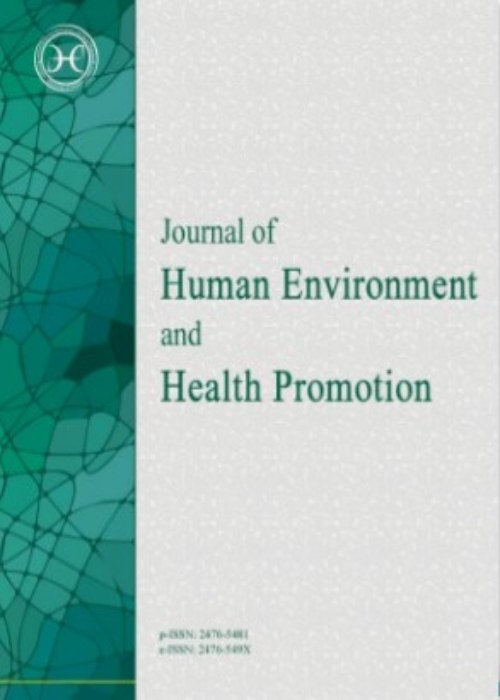فهرست مطالب

Journal of Human Environment and Health Promotion
Volume:1 Issue: 1, Winter 2015
- تاریخ انتشار: 1394/11/29
- تعداد عناوین: 8
-
Pages 1-11BackgroundQual2k is a stream water quality model and was used to evaluate the water quality of the Kine-Vars River and assess the response of the river to nutrient management strategies.MethodsFor that purpose, 7 sample stations were selected and surface water samples were collected in the winter and summer of 2012 and were analyzed for temperature, dissolved oxygen, biological oxygen demand, ammonianitrogen, nitratenitrogen, organic nitrogen, organic phosphorus, and inorganic phosphorus.ResultsResults showed that the Kine-Vars River is saturated with N and P and is classified as eutrophic. The simulated data showed that the total nitrogen and total phosphorus loads of the studied river need to be reduced by 76% and 93%, respectively, to reach water quality objectives.DiscussionApplication of nutrient control strategies can reduce the nutrient loads significantly but is not sufficient to change the river classification from eutrophic to oligotrophic in a short time thus, additional nutrient control measures are necessary.Keywords: Qual2k, Modeling, Nutrients, Water quality, Kine, Vars, Zanjan
-
Pages 12-18BackgroundCarpet weaving is an occupation that requires sufficient and appropriate lighting. The lighting in carpet weaving workshops affects the productivity and the physical and mental health of workers. Therefore, the evaluation of the illumination and the identification of work stations requiring lighting modifications will be helpful in promotion of the health and safety of workers in carpet weaving workshops.MethodsThis study was carried out for the evaluation of illumination on the basis of Geospatial Information System (GIS) technology in two carpet weaving workshops of Bokan city. As per the norms of Illumination Engineering Society, the sensors of the photometer Testo 545 were placed at lowest and highest of 35 and 163 cm in workshop I, and at 40 and 245 cm in workshop II, which correspond to the lowest and highest work surfaces in the respective workshops. Total, natural, and artificial illuminance was measured in the center of each measurement station using the photometer, and data was analyzed using the Arc GIS software. The maximum and minimum illuminances as well as isolux curves were obtained for each workshop.ResultsThe illuminance in workshops I and II were found to be lower and higher, respectively, than 200 lux, which is considered the standard for carpet weaving workshops. Thus, improving the artificial lighting system or redesigning it is essential for ensuring that the standard conditions of illuminance (200300 lux) are provided.DiscussionThis study showed that the application of GIS technology renders the assessment of illumination in carpet weaving workshops possible. This assessment method could also prove useful for determining the exact stations in the carpet weaving workshops that need modifications, thereby leading to cost reduction.Keywords: carpet weaving, lighting, illuminance, isolux curve, GIS
-
Pages 19-27Background And ObjectivePrevention of accidentsa crucial requirement in oil industriesinvolves hazard recognition, risk assessment, and corrective actions. The purpose of this study was to compare the ETBA and HAZOP techniques for risk assessment in a gasoline refinery unit.MethodsIn this case study, data were collected using process flow diagram, walkingtalking through method, piping and instrumentation diagram, and direct observations. Worksheets for both techniques were filled on the basis of the risk assessment matrix MIL-STD-882E.ResultsThe HAZOP method identified 44 deviations attributable to 118 causes. In addition, 11.37% of the identified hazards were associated with unacceptable risk, and 36.36%, with unfavorable risk. The ETBA method detected 10 groups of energy (24 subgroups) 33 hazards were detected, 10.62% of which were associated with unacceptable risk.ConclusionsHAZOP proved to be the more powerful technique for the prediction and identification of hazards. However, ETBA detected certain hazards that were not identifiable using HAZOP. Therefore, a combination of these two methods is desirable for the assessment of hazard risk in process industries.Keywords: oil refinery, hazard, ETBA, HAZOP
-
Pages 28-34BackgroundTitanium dioxide (TiO2)-mediated photocatalysis has been found to be an efficient method of water treatment and is capable of degrading a wide range of organic pollutants and microbial agents with high efficiency. The microorganism Pseudomonas aeruginosa is resistant to chemicals and UV irradiation. Bacteria which are resistant to UV-induced oxidative damage of the cell membrane are susceptible to photocatalytic technology. The main objective of this research was to examine the photocatalytic removal of P. aeruginosa upon UV irradiation in the presence of TiO2 nanoparticles.MethodsPolluted water samples were prepared by the addition of P. aeruginosa colonies into water, followed by contact with UV, TiO2, or a combination of the two in separate stages. The effect of various parameters, including contact time, pH, and TiO2 concentration, on reaction efficiency was examined.ResultsThe highest efficiency of bacterial disinfection was achieved with UV irradiation in the presence of TiO2 nanoparticles, with complete (100%) removal of P. aeruginosa observed upon irradiation for 60 min in the presence of 0.4 g/L TiO2 under conditions of neutral pH.ConclusionsThe results of this study suggest that from a technical and economic perspective, the UV/TiO2 process may be effectively applied for the disinfection of polluted water. This process could be considered a promising method of cleaning and purification, and applicable for water disinfection.Keywords: Advanced Oxidation Processes (AOPs), Water disinfection, Pseudomonas aeruginosa, Titanium dioxide, UV irradiation, Pseudo, first order kinetics
-
Pages 35-41BackgroundAttention deficit and hyperactivity disorder is a common disorder that causes serious problems in elementary school and it is also implicated in crime statistics, aggression and other behavioral problems in society. This study estimated the prevalence of hyperactivity in elementary school children in Saghez City, Iran, at the age of 6 11 years.MethodsIn this study, 760 students were selected from elementary school boys and girls equally, from Saghez. A type of cross-sectional multi-stage random sampling method was used, and from the elementary school students academic year, 12 to 2011 were selected. First, variables such as age, gender, grade level, school status, Children age, employment, parents level of education, family size, childs birth order, and parental psychiatric history were collected. Second, the teacher and parent questionnaire, "ADHD rating scale-IV," which consisted of two parts, was used. For the data collection, a copy of the letter was given to the teacher to complete and the questionnaires delivered. After completion, collected data was analyzed using the SPSS, 11.5 software.ResultsThe results showed that the prevalence of ADHD in the children was 34/4%, and by gender: girls 34/2% and boys 34/6%. Higher numbers of hyperactivity disorders were found in families whose parents had lower levels of education. Hyperactivity was observed to be higher in the third and fourth children who were born into larger families, but there was no significant correlation found between the prevalence of hyperactivity and the number of family members (p = 0/16).ConclusionThe results of this study indicate that the development of training programs for disease prevention and managing hyperactivity disorder, in families with low socio-economic should be a priority.Keywords: Attention deficit, hyperactivity disorder, Prevalence, Elementary school children, Saghez City
-
Pages 42-49BackgroundBio aerosols include airborne micro-organisms such as bacteria, fungi, viruses, etc and their products. Exposure to a bio aerosol is linked with a broad spectrum of health problems, including infectious diseases, acute toxic effects, allergies, and cancer. The aim of this study was to evaluate the quality and quantity of bio aerosols found in the air of different wards in Valiasr Hospital, Zanjan, in summer and fall 2012.MethodsAir samples were collected from six wards including: operating room, infectious, ear, nose, and throat (ENT), surgery, adult intensive care unit (ICU), oncology and administrative with a single-step Anderson sampler. The type and number of colonies were determined in the laboratory, and then the bio aerosol density were calculated in terms of cfu/m3 and compared with the recommended limits.ResultsThe most common genera of isolated bacteria and fungi were Staphylococcus and Penicillium, respectively. In the infectious ward bacterial density was higher than the recommended limit of WHO (100cfu/m3) in the visiting times (afternoon). The fungal density in the meeting time (afternoon) in the ICU, ENT, and general surgery, infectious and administrative wards, and in non-visiting times (morning) in the infectious ward was higher than the recommended limit of WHO (50 cfu/m3).ConclusionFrom the findings of this study it can be concluded that the density of fungi and bacteria in the hospital air in some times of working period are higher than recommended levels and therefore, the condition of existing air filtration and ventilation systems should be appropriated according to the international standards of hospitals buildingsKeywords: Bio aerosol, Valiasr hospital, Zanjan
-
Pages 50-57BackgroundBreast cancer is the most common cancer found in women, and screening is the best way to make an early diagnosis. The aim of this study was to determine the rate of screening mammography and related variables in the mammography center of Mousavi Hospital, located in Zanjan, Iran.MethodsThis was a prospective descriptive study. Study sample size was 526 women who were selected by a convenience sampling method. Data collection instrument was a multi-section questionnaire and this was completed by a trained radiology technologist through interviews. In cases referred to ultrasonography or histopathological evaluation, follow-up of the women was conducted to obtain their results.ResultsResults showed that the rate of screening mammography was 27.4%. Educated women and women who had a family history of breast cancer, were more likely to have a screening mammography. Among the referrals, 71% were between the age of 30-50 years and the most common complaint in the diagnostic mammography patients was breast pain. The findings of mammography in 33% of patients were normal, 2.3% were malignant and the rest of the cases were as follows: dense breast, axillary lymph node, benign mass, fibrocystic breast and calcification. For the women who had a further evaluation 26% were referred to ultrasonography, and 1.4% were referred for a breast biopsy. The findings of ultrasonography and pathology confirmed malignancy in 4 women.ConclusionAccording to the studys results, there is a need to provide information and mass education about screening mammography, breast cancer risk factors and symptoms in Zanjan.Keywords: Breast cancer, Screening, Mammography
-
Pages 58-64BackgroundToday some bakeries for artificially production of bread in order to production process expedition and compensating defects that created by unnatural fermentation and as well as undesirable quality of flour. For cover superficial defects of bread use of harmful chemical material such as soda, that can cause health problems. The aim of this study is determination of soda and salt amount of bread bakeries in the Zanjan city.MethodTotal number of samples is 450 which includes 330 bread samples, 77 Barbari bread and 43 other breads (Sangak, Tafton, Shirmal). The collected data were analyzed by SPSS 11.5.ResultsThe most amounts of soda and salt observed in barbari breads with 55.8 and 11.7 percent, respectively. Use of soda in autumn and winter seasons, respectively with 31.9 and 41.4 percent had been maximum amount.ConclusionTotal average of pH is higher than standard in bakeries. That from reasons can noted to undesirable quality of flour, unawareness of bakers and lack of adequate oversight.Keywords: baking soda, salt, bread, Zanjan


